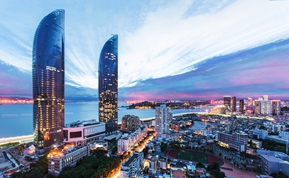Yearly event encourages creative collaboration
By Hu Meidong and Liu Xiaoyu in Xiamen, Fujian ( China Daily )
Sean Shih, one of the organizers of the seventh Cross-Straits (Xiamen) Cultural Industries Fair, or CCCIF, said the event serves as a platform for artists and craftspeople from both sides to communicate and also paves the way for further collaboration.
The event, held from Oct 24 to 27 in the coastal city of Xiamen, Fujian province, plays an important role in promoting the fine art industry.
As a highlight of this year's CCCIF, some 400 outstanding art pieces and handcrafts from the Chinese mainland and Taiwan were shortlisted by a panel of professional judges for a special contest.
These artworks, together with another 100 from well-known handcraft masters, are displayed in the central area of Xiamen's International Conference and Exhibition Center.
As a pioneering appraisal concerning artworks co-hosted by cross-Straits organizations, the contest has gained in popularity over time. Launched in late August, it attracted more than 1,000 entries in two months, three times the number last year.
The CCCIF organizing committee said the contest results would be announced on Monday.
"This is a good opportunity for Taiwan artists to learn and be inspired by the talents and masters from the other side of the Straits," Shih said.
In addition to traditional standards of judgment, innovative spirit will be rewarded this year, as there is a special prize for unique designs and techniques. Innovation has become a major trend in the industry in Taiwan.
Hsu Keng-Hsiu, the director of a Taiwan craft research and development institute, showed a variety of eye-catching designs blending traditional materials with modern elements at a CCCIF summit seminar on Friday.
Traditional materials such as wood, ceramic, bamboo and gold are rejuvenated with fashionable patterns, as well as pragmatic functions.
"We are trying hard to inject innovative thinking into the traditional handcrafts industry. We appreciate what the 5,000-year civilization has given us, but now it seems some craftsmen are stuck in the mud," Hsu said.
The Taiwan craft research and development institute, along with many universities on the island, have put forward proposals to foster talented artists and craftsmen.
"We provide professional guides to university students who come up with potential ideas, as well as supporting them with sufficient funds.
"On the other hand, we invite artists and craftsmen from all around the world to Taiwan - this is the way to refresh our experienced artists with revolutionary concepts," Hsu said.
Such efforts have reaped sizable profits at this year's CCCIF. A contract worth NT$400 million ($13.15 million) was signed between the Taiwan institute and a company in Xiamen that makes stylish ceramic tea sets. The contract stipulates that 100 fashion-designed handcrafts will be commissioned from 200 Taiwanese artists and craftsmen.
A wide range of cultural exchange activities are being held during this year's CCCIF, including a cross-Straits Porcelain Expo and a Taiwan Cultural and Creative Products Shopping event.
Huang Ting-Yi, an assistant professional at Taiwan's Shih Chien University, said, "Xiamen has become a gateway for us to know about and communicate with talented people with vision in different fields."
(China Daily 10/27/2014 page24)
Why Xiamen
-

Xiamen is one of the most economically competitive cities in China and was one of the first Special Economic Zones on the Chinese mainland. As a vice-provincial city independently listed on the State development plan, it has provincial-level authority in economic administration and local legislative power. In 2010, the Xiamen SEZ was expanded to cover the entire municipality. Today, Xiamen is a modern and international port city.
